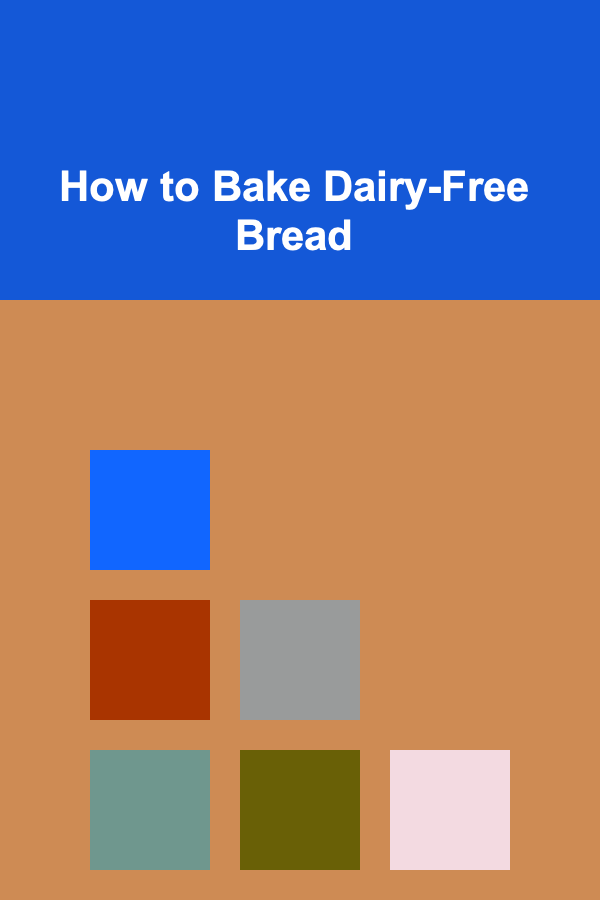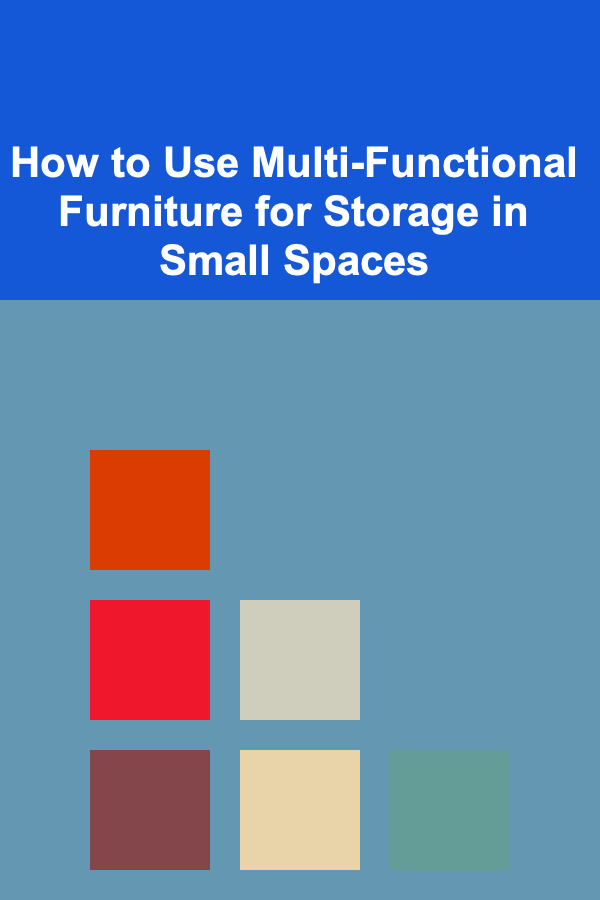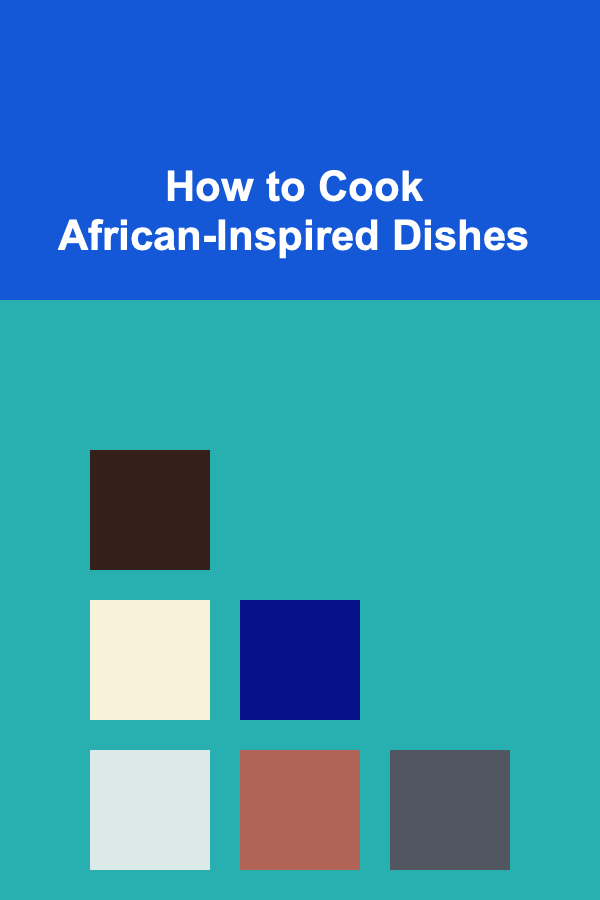
How to Bake Dairy-Free Bread
ebook include PDF & Audio bundle (Micro Guide)
$12.99$8.99
Limited Time Offer! Order within the next:

Bread is a staple food that transcends cultures, with countless variations found across the globe. However, for those with dietary restrictions or preferences---whether due to lactose intolerance, veganism, or other health concerns---baking bread without dairy can present a challenge. The good news is that with a few simple substitutions, it's entirely possible to create delicious, dairy-free bread that rivals its traditional counterpart.
This article will explore the process of baking dairy-free bread, including the essential ingredients, techniques, and tips for success. We'll dive deep into the nuances of ingredient substitutions, the science behind bread-making, and how to achieve the perfect loaf without dairy. Whether you are new to dairy-free baking or a seasoned baker looking to adapt your recipes, this guide will equip you with everything you need to make a beautiful loaf of dairy-free bread from scratch.
Understanding Dairy-Free Baking
The Role of Dairy in Traditional Bread Recipes
Before we can fully grasp the process of making dairy-free bread, it's important to understand the role dairy plays in traditional bread-making. Dairy products such as milk, butter, and cream often serve several functions in bread recipes:
- Flavor: Dairy adds a subtle richness and depth of flavor to the bread.
- Texture: The fats in butter and milk help produce a softer, more tender crumb. Milk proteins contribute to the structure, giving the bread a fine texture.
- Browning: The natural sugars in dairy contribute to the Maillard reaction during baking, leading to a golden-brown crust.
- Moisture: Dairy products help to keep the bread moist, which can improve its shelf life.
For those who are looking to avoid dairy, it's essential to find alternatives that mimic these effects without compromising the flavor, texture, and overall quality of the bread.
Common Dairy-Free Alternatives
To create a successful dairy-free bread, we need to replace the dairy components with suitable alternatives. Here are some common dairy-free substitutes for the ingredients typically found in bread recipes:
- Milk Alternatives: Instead of cow's milk, you can use plant-based milks such as almond milk, oat milk, soy milk, or coconut milk. Choose an unsweetened variety to maintain control over the bread's flavor. These alternatives offer a similar texture to milk and help with hydration.
- Butter Alternatives: Butter can be replaced with dairy-free margarine, vegetable oil, or coconut oil. These fat substitutes provide moisture and richness, ensuring a tender crumb. For an added flavor dimension, you might also use olive oil or avocado oil.
- Yogurt Substitutes: If your recipe calls for yogurt, you can use dairy-free yogurt made from coconut, almond, or soy. These alternatives can replicate the tangy flavor and creamy texture that yogurt provides.
- Egg Alternatives: For those who avoid eggs in addition to dairy, flaxseed meal (mixed with water to form a gel) or chia seeds can replace eggs. Additionally, applesauce, mashed bananas, or aquafaba (the liquid from canned chickpeas) can provide the binding properties that eggs normally offer.
- Cheese Substitutes: While bread doesn't always contain cheese, many recipes (such as cheese bread or stuffed breads) do. Dairy-free cheese made from nuts (like cashew or almond-based cheeses), soy, or coconut is widely available.
By understanding the basic roles of dairy in bread, we can ensure that our substitutes effectively mimic the essential components, creating a product that still feels indulgent and satisfying.
Key Ingredients for Dairy-Free Bread
Flour
Flour is the backbone of any bread recipe. It provides the structure and texture of the loaf. The most common type of flour used for bread is all-purpose flour, though other options like whole wheat flour, rye flour, and gluten-free flour blends can also be used depending on dietary needs and personal preference. When baking dairy-free bread, be sure to use unbleached flour to ensure the best possible results.
Yeast
Yeast is what causes the bread to rise and gives it its airy texture. The two most common types of yeast used in bread-making are active dry yeast and instant yeast. Both work similarly, but instant yeast can be added directly to dry ingredients without needing to be proofed in warm water first.
Water
Water is an essential ingredient in bread-making, activating the yeast and helping to hydrate the flour. For dairy-free bread, ensure that the water is warm (but not too hot) to help the yeast activate properly.
Salt
Salt is critical for flavor, and it also helps regulate yeast activity. While it may seem like a minor ingredient, salt enhances the overall taste of the bread and helps control the fermentation process.
Sweeteners
Sweeteners are often added to bread to feed the yeast and encourage fermentation. For dairy-free bread, you can use traditional sugar, maple syrup, agave nectar, or coconut sugar. The choice of sweetener may slightly affect the flavor of the bread but should not interfere with its overall success.
Oil or Fat
Instead of butter, oils such as vegetable oil, olive oil, or coconut oil can be used to provide moisture and richness to the dough. Fat also helps tenderize the bread, ensuring that the crumb stays soft and light.
Step-by-Step Process for Baking Dairy-Free Bread
Now that we understand the ingredients, let's dive into the step-by-step process of making dairy-free bread. We'll walk through a basic recipe for a simple dairy-free loaf, which can be adapted and modified to suit your preferences.
Step 1: Prepare the Ingredients
Start by gathering all your ingredients. For this recipe, you'll need:
- 3 cups of all-purpose flour
- 1 tablespoon of active dry yeast
- 1 teaspoon of salt
- 1 tablespoon of sugar
- 1 cup of warm water (about 110°F)
- 2 tablespoons of olive oil (or another dairy-free fat)
- 1 cup of dairy-free milk (such as almond milk or oat milk)
Make sure that the water and milk are warm (but not hot) to ensure that the yeast activates properly.
Step 2: Activate the Yeast
In a small bowl, combine the warm water, sugar, and yeast. Stir until the sugar dissolves, then let it sit for about 5-10 minutes. You'll notice that the mixture will start to bubble and foam---this indicates that the yeast is activated and ready to go.
Step 3: Mix the Dough
In a large bowl, combine the flour and salt. Make a well in the center and pour in the activated yeast mixture and the dairy-free milk. Add the olive oil (or your preferred fat) and stir to combine. Mix the ingredients until they form a sticky dough.
Step 4: Knead the Dough
Transfer the dough to a lightly floured surface and begin kneading. Knead for about 8-10 minutes, or until the dough becomes smooth and elastic. If the dough is too sticky, sprinkle a little more flour, but be careful not to add too much. The dough should be slightly tacky but not overly sticky.
Step 5: Let the Dough Rise
Place the kneaded dough into a greased bowl and cover it with a damp towel or plastic wrap. Let it rise in a warm place for about 1-1.5 hours, or until it has doubled in size. The exact time may vary depending on the temperature of your kitchen.
Step 6: Shape the Dough
Once the dough has risen, punch it down to release the air. Turn it out onto a floured surface and shape it into a loaf. Place the shaped dough into a greased loaf pan or shape it into a round boule and place it on a parchment-lined baking sheet.
Step 7: Final Rise
Cover the shaped dough with a damp towel or plastic wrap and let it rise for another 30-45 minutes, or until it has puffed up again.
Step 8: Preheat the Oven
While the dough is undergoing its final rise, preheat the oven to 375°F (190°C). This temperature is ideal for baking most types of bread, including dairy-free loaves.
Step 9: Bake the Bread
Once the dough has completed its final rise, place the loaf in the preheated oven. Bake for 30-35 minutes, or until the bread is golden brown on top and sounds hollow when tapped on the bottom. If you're using a loaf pan, make sure the bread is fully cooked through by testing it with a toothpick or skewer.
Step 10: Cool and Enjoy
Remove the bread from the oven and allow it to cool on a wire rack. Let it cool completely before slicing to avoid it becoming too dense. Enjoy your freshly baked dairy-free bread with your favorite toppings, such as avocado, peanut butter, or a simple spread of dairy-free butter.
Tips for Perfect Dairy-Free Bread
- Hydration: Make sure your dough is properly hydrated. If it's too dry, the bread will be dense. If it's too wet, it may not hold its shape during baking.
- Use Warm Water: The yeast needs warmth to activate, but too hot water can kill the yeast. Aim for water that's around 110°F (43°C).
- Allow for Rising Time: Don't rush the rising process. Let the dough rise properly to ensure it develops a light, airy texture.
- Experiment with Flours: Try whole wheat, spelt, or other flour types for a different flavor and texture.
- Flavor Additions: For added flavor, you can include herbs, garlic, or seeds (like sesame or sunflower) to the dough.
Conclusion
Baking dairy-free bread is not only feasible but also incredibly rewarding. By using simple ingredient substitutions, you can create a loaf that is just as flavorful, tender, and satisfying as its dairy-filled counterparts. With the right techniques, attention to detail, and a little patience, anyone can bake beautiful dairy-free bread at home. So, roll up your sleeves, gather your ingredients, and enjoy the process of crafting your very own homemade loaf!
Reading More From Our Other Websites
- [Home Maintenance 101] How to Perform Basic Water Heater Maintenance to Extend Its Lifespan and Save Money
- [Personal Care Tips 101] How to Use Concealer for a Soft, Blended Look
- [Home Storage Solution 101] How to Optimize Closet Space with Space-Saving Hangers and Organizers
- [Home Family Activity 101] How to Set Up a Family Puzzle Night for Team Building
- [Personal Financial Planning 101] How to Prepare for a Financially Stress-Free Holiday Season
- [Home Rental Property 101] How to Identify Rentals with a Gas Range: Cooking with Efficiency and Flavor
- [Needle Felting Tip 101] Best Strategies for Storing and Organizing Large Quantities of Felting Wool
- [Tie-Dyeing Tip 101] Best Tie‑Dye Color Blending Techniques for Vibrant Results
- [Paragliding Tip 101] Essential Paragliding Rescue Gear: What Every Pilot Should Carry
- [Home Space Saving 101] How to Create a Cozy Home Office in a Small Space

How to Build a Study Routine Checklist for Academic Success
Read More
How to Use Multi-Functional Furniture for Storage in Small Spaces
Read More
How to Master the Pomodoro Technique
Read More
How to Grasp the Principles of Fast Charging Hubs
Read More
How to Cook African-Inspired Dishes
Read More
10 Tarot Spreads for Self-Discovery
Read MoreOther Products

How to Build a Study Routine Checklist for Academic Success
Read More
How to Use Multi-Functional Furniture for Storage in Small Spaces
Read More
How to Master the Pomodoro Technique
Read More
How to Grasp the Principles of Fast Charging Hubs
Read More
How to Cook African-Inspired Dishes
Read More